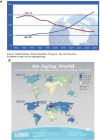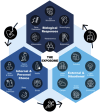Global challenges in aging: insights from comparative biology and one health
- PMID: 38873623
- PMCID: PMC11169734
- DOI: 10.3389/ftox.2024.1381178
Global challenges in aging: insights from comparative biology and one health
Abstract
The well-being of wildlife populations, ecosystem health, and human health are interlinked, and preserving wildlife is crucial for sustaining healthy ecosystems. Wildlife numbers, and in particular avian populations, have steeply declined over the past century, associated with anthropogenic factors originating from industry, urbanization, changing land use, habitat loss, pollution, emerging diseases, and climate change. All these factors combine to exert increasing stress and impair health for both humans and wildlife, with diminished metabolic, immune, and reproductive function, deteriorating overall health, and reduced longevity. The "toxic aging coin" suggests that these stressors may have dual impacts on aging-they can accelerate the aging process, and older individuals may struggle to cope with pollutants compared to younger ones. These responses are reflected in the health and productivity of individuals, and at a larger scale, the health and ability of populations to withstand disturbances. To understand the potential risk to health over the lifespan, it is important to articulate some of these global challenges and consider both their impacts on aging populations and on the aging process. In this review, we use the toxic aging coin and One Health conceptual frameworks to examine the interconnected health of humans, wildlife, and ecosystems. This exploration aims to develop proactive approaches for optimizing wildlife and human health.
Keywords: ecosystem resilience; exposome; human health; one health; pollution; sustainability; toxic coin; wildlife health.
Copyright © 2024 Ottinger, Grace and Maness.
Conflict of interest statement
The authors declare that the research was conducted in the absence of any commercial or financial relationships that could be construed as a potential conflict of interest. The author(s) declared that they were an editorial board member of Frontiers, at the time of submission. This had no impact on the peer review process and the final decision.
Figures









Similar articles
-
One Health and the Exposome: providing insights for wildlife health and reproduction.F S Rep. 2025 Apr 15;6(Suppl 1):55-62. doi: 10.1016/j.xfre.2025.02.001. eCollection 2025 Apr. F S Rep. 2025. PMID: 40487324 Free PMC article.
-
The Minderoo-Monaco Commission on Plastics and Human Health.Ann Glob Health. 2023 Mar 21;89(1):23. doi: 10.5334/aogh.4056. eCollection 2023. Ann Glob Health. 2023. PMID: 36969097 Free PMC article. Review.
-
Climate Change in the North American Arctic: A One Health Perspective.Ecohealth. 2015 Dec;12(4):713-25. doi: 10.1007/s10393-015-1036-1. Epub 2015 Jun 13. Ecohealth. 2015. PMID: 26070525
-
Overcoming the coupled climate and biodiversity crises and their societal impacts.Science. 2023 Apr 21;380(6642):eabl4881. doi: 10.1126/science.abl4881. Epub 2023 Apr 21. Science. 2023. PMID: 37079687 Review.
-
Old World Vultures Reflect Effects of Environmental Pollutants Through Human Encroachment.Environ Toxicol Chem. 2022 Jul;41(7):1586-1603. doi: 10.1002/etc.5358. Epub 2022 Jun 8. Environ Toxicol Chem. 2022. PMID: 35673892 Review.
Cited by
-
The Role of Genetic Variation in Shaping Phenotypic Responses to Diet in Aging Drosophila melanogaster.bioRxiv [Preprint]. 2025 Jan 14:2025.01.09.632132. doi: 10.1101/2025.01.09.632132. bioRxiv. 2025. PMID: 39868103 Free PMC article. Preprint.
References
Publication types
LinkOut - more resources
Full Text Sources
Miscellaneous

